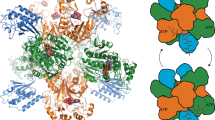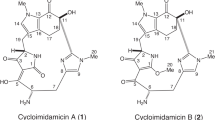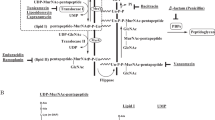Abstract
PUROMYCIN dihydrochloride is being extensively used as an inhibitor of protein synthesis. This antibiotic inhibitor is valuable because its mode of action on protein biosynthesis has been elucidated in precise molecular terms1. Examination of the literature shows, however, that there is a considerable range in the reported potencies of different samples of the inhibitor. For example, Wheelock found that 10−4 M (about 50 µg/ml.) puromycin completely inhibited protein synthesis in HeLa cells within 45 min of treatment2, while Shah's data, also on HeLa cells, show that twice that amount of puromycin (100 µg/ml.) allowed protein synthesis to take place at 20 per cent of the control rate after 6 h of puromycin action3. Numerous other examples of such discrepancies can be found4–7. This communication draws attention to the fact that different batches of the compound may vary in potency.
This is a preview of subscription content, access via your institution
Access options
Subscribe to this journal
Receive 51 print issues and online access
$199.00 per year
only $3.90 per issue
Buy this article
- Purchase on Springer Link
- Instant access to full article PDF
Prices may be subject to local taxes which are calculated during checkout
Similar content being viewed by others
References
Nathans, D., Proc. U.S. Nat. Acad. Sci., 51, 585 (1964).
Wheelock, E. F., Proc. U.S. Nat. Acad. Sci., 48, 1358 (1962).
Shah, V. C., Cancer Res., 23, 1137 (1963).
Mueller, G. C., Kajiwara, K., Stubblefield, E., and Rueckert, R. R., Cancer Res., 22, 1084 (1962).
Baltimore, D., and Franklin, R. M., Biochim. Biophys. Acta, 76, 431 (1963).
Holland, J. J., Proc. U.S. Nat. Acad. Sci., 50, 436 (1963).
Tamaoki, T., and Mueller, G. C., Biochem. Biophys. Res. Commun., 11, 404 (1963).
Studzinski, G. P., and Love, R., J. Cell Biol., 22, 493 (1964).
Scott, J. F., Fraccastoro, A. P., and Taft, E. B., J. Histochem. Cytochem., 4, 1 (1956).
Schmidt, G., and Thannhauser, S. J., J. Biol. Chem., 161, 82 (1945).
Hinrichs, H. R., Petersen, R. O., and Baserga, R., Arch. Path., 78, 245 (1964).
Baserga, R., Estensen, R. D., Petersen, R. O., and Layde, J. P., Proc. U.S. Nat. Acad. Sci., 54, 745 (1965).
Ben-Porat, T., and Kaplan, A. S., Virology, 25, 22 (1965).
Jackson, L. G., and Studzinski, G. P., Excerpta Medica, 19, xxvii (1965).
Author information
Authors and Affiliations
Rights and permissions
About this article
Cite this article
STUDZINSKI, G., BASERGA, R. Instability of Puromycin. Nature 212, 196–197 (1966). https://doi.org/10.1038/212196a0
Issue Date:
DOI: https://doi.org/10.1038/212196a0
This article is cited by
-
Studies on the site of replication of vesicular stomatitis virus
Archiv f�r die gesamte Virusforschung (1968)
Comments
By submitting a comment you agree to abide by our Terms and Community Guidelines. If you find something abusive or that does not comply with our terms or guidelines please flag it as inappropriate.



